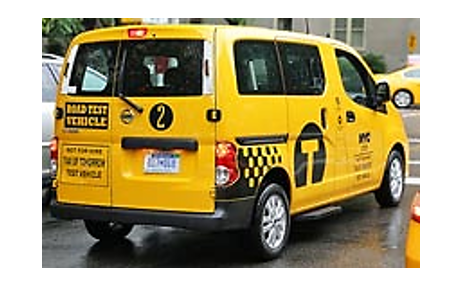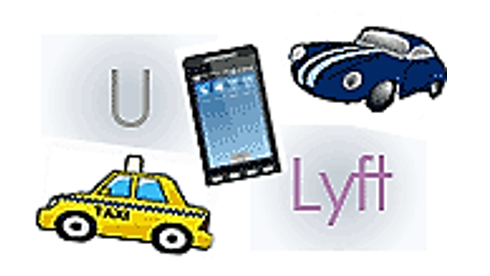You might recall, previously we discussed the "Taxi of Tomorrow," New York City's taxi design contest. We called attention to the peril of new product development without understanding stakeholders and offered some QFD perspectives.
Now that the winning model, Nissan NV200 minivan, is being rolled out to replace the aging fleet of NYC cabs, are New Yorkers happy? Not so fast. The debate continues, according to recent articles. [*Reference 1]
The Nissan model, based on a Japanese family van never tested in a commercial fleet until now, offers features such as a spacious interior, rear seat airbags, driver GPS, and charging ports for electronic devices.
The critics complained that the Nissan model is only a gasoline fueled vehicle (at least for now) and does not offer wheelchair accessibility. Emissions are a big concern for this city of over 13,437 licensed taxi vehicles that roam around 24/7. The handicap accessibility is also important for this city of 54.3 million visitors per year 2 and over 1.9 million residents who are 70 years old or older 3. Interestingly, accessibility was one of the published criteria but seemed to have fallen out in the final selection over other priorities. I wonder if they used ‘ordinal scale ratings’ and thus lost precision.
In any case, conceding to these important points, the mayor has agreed to allow non-Nissan models for the taxi owners who are willing to buy handicap accessible or hybrid vehicles, it is reported. Intriguingly, it caught our eyes that the contest decision makers (politicians, taxi and limousine commissioners, industry leaders) gravitated toward the established, practical product features for the final selection, such as:
Safety (passenger airbags around the partition, sliding doors, floor lighting, etc.)
Comfort (no-hump floor, flat seat, passenger climate control, spacious cabin, swing-out step, etc.)
Passenger amenities (USB ports and electrical outlets, sunroof, reading light, ease of entry and exit, roomier luggage capacity, etc.)
Economy (low costs, fuel economy)
Driver amenities (GPS, intercom, extra leg room, comfortable front seat, etc.)
In the pre-decision survey, the general public additionally voiced these important features:
Environmental friendliness
Forward-looking design fit for the international center of business, arts, and tourism
What neither party articulated, during and after the contest, were the "true" needs of customers, especially the latent ones.
That may be why Uber, Lyft, and others are able to make a dent in the market share of traditional taxis. Note here, the differentiating points of app-based transportation are no longer what types of vehicle it is or what amenities it is equipped with. It is not even so much about the cost of the ride, either, according to some users of these services.
This may come as shocking to those who worked hard to bring the winning design onto the streets of Manhattan. But with the entry of this new app-based, on-demand competition, the physical features that the Taxi of Tomorrow has focused have become irrelevant—as if the Taxi of Tomorrow addresses the needs of yesterday!
The city officials are hopeful the new taxi will bring back customers, but it seems they need more than an eye-catching new design to successfully compete in this new market.
How can they turn the Taxi of Tomorrow truly live up to its name?
Taxis are a regulated industry in the U.S., so the leaders of both industry and the city must work together, just as a successful QFD project includes cross-functional members such as marketing, engineering, IT, supply chain, R&D, production, manufacturing, support, etc.
Successful QFD new product development projects share other common elements, such as:
They are applicable to any industry and product/service/information.
They translate the voice of the customer (VOC) into “true” customer needs using QFD's "bonehead specs" version of the Ishikawa diagram. "Easy entry and exit" is not a customer need. Neither is "roomy interior," "GPS," "fuel economy," etc. In fact, none of the contest criteria that the officials relied on for selecting the Taxi of Tomorrow are customer needs. This throws off the integrity of the prioritization by asking customers to evaluate features instead of their needs. Thus, the subsequent analysis was built on this faulty foundation.
Identifying the "true" customer needs and clarifying functional requirements as the basis for building innovative solutions beyond simple upgrades of what is offered today. When you begin new product development based on a product feature, "fuel economy" for example, all you will get are approaches to tinkering with the exhaust system, engine, computer software, etc. But when you focus on a customer need like "we want to fit our image as an international center of business and arts" for example, you will be able to see broader and more creative avenues to address the need.
Aligning the identified and prioritized true customer needs with your business goals. This is necessary to see the project as fitting into a larger, more strategic role involving the viewpoints of many stakeholders, operating environments and applications. This step requires advance QFD skills (taught in QFD Black Belt® course) and is invaluable to strategic development. This is where you can:
Identify strategically competitive niche markets;
Innovate options and technologies;
Explore and devise policies and strategies in anticipation of future solutions spaces such as driver-less technology, etc.;
Manage uncertainty and ambiguity;
Explore non-functional as well as functional solutions. This is one of new contributions by Modern QFD where advanced methods such as Hoshin, New Kano Model, TRIZ, Kansei, etc. can be efficiently integrated as needed.
New Yorkers deserve a Taxi of Tomorrow that they can be proud of as the icon of a city that is dynamic, diverse, creative, and successful -- the pulse that draws millions of visitors from all over the world year after year.
* References
1: Huffington Post, Gizmodo
2: 2013 statistic, NYC Visitors Bureau
3: 2013 estimate, www.health.ny.gov


